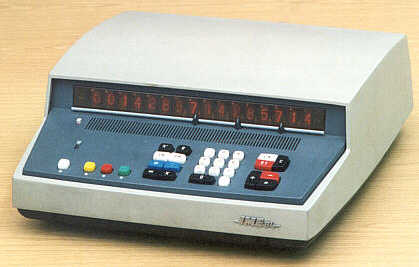
|

IME 84 Desktop Calculator

Sincere thanks to Klemens Krause, Computermuseum der Informatik Universität Stuttgart, for use of the above image
The IME 84 is the first electronic calculator introduced by the Italian company
IME (Industria Macchine Electroniche). The machine is among the earliest
transistorized desktop calculators produced. The IME 84 was first
shown in Europe in March of 1964, and began sales in Europe not long
after that. The calculator was introduced in the US at the BEMA (Business
Equipment Manufacturers Association) show in Los Angeles in October, 1964,
though it took some time for a distribution network to be set up in the
North America, with general availability of the IME calculators in the US beginning
in early 1966.
Like other early transistorized electronic calculators,
the IME 84 uses Germanium-based transistors as at the time, Silicon transistors were
still too expensive. The machine uses a small magnetic core memory plane for register
storage, utilizes multiplexed Nixie tubes for display, and has a three register
math architecture. The design of the IME 84 is quite elegant, with an architecture
that was based on computer design concepts, and was superior in many ways
to the many of its contemporaries. The IME 84 is very well built, both
electronically and mechanically. The machine is based on a backplane
that a selection of relatively small circuit boards plug into, with each
board generally containing a specific function, with the neatly hand-wired
backplane connecting them together.
The chassis for the circuit boards is well thought out, with good spacing
between the boards for cooling and access for troubleshooting, but
organized to keep the machine as compact as possible. To avoid any possibility
of shorts between the component side of one board and the trace side of the adjoining
board, plastic sheet inserts slid in between the circuit boards.
The IME 84 was physically the smallest electronic calculator on the market for quite some time,
with a low, wide profile that gave ample room for spacious keyboard,
as well as a large display panel that spanned nearly the width
of the calculator making for easy reading. This wide display allowed for
the use of Nixie tubes with larger digits, furthering the ease of reading
of the display. Discrete neon bulbs are positioned between the digits for
indication of the decimal point.
The IME 84 had a capacity of sixteen digits, and offered a single accumulator-style
memory register. The display consisted of sixteen large Nixie tubes, with individual
neon lamps situated between the tubes that acted as decimal point indicators.
The calculator provided the standard four functions, along with a unique for the
time exponentiation key, that utilized repeated multiplication to raise a number
to an integer power. The IME 84 had three working registers, and used an unusual
method for managing the registers, with separate keys providing a method for
calling a working register to the display.
There were three different versions
of the IME 84 offered, the original IME 84, the IME 84rc (for "Remote Control"),
which added a port on the left side of the calculator to allow plug-in of a remote keyboard/display unit
(up to four). Only one of the remote keyboard/display units could be used
at a time, though. When the main calculator was being used, the remote
keyboard/display units were locked out, and likewise, if one of the remote
keyboard/display units was being used, the other remotes as well as the main
calculator were locked out. This is in contrast to Wang Laboratories
"SE" series (e.g., the Wang 360SE,
where all four remote keyboard/display units could be operated simultaneously.
Lastly, there was the IME 84m, which was marketed as a simplified version of the
IME 84 that lacked the accumulator-style memory register.
The IME 84's European origin made it very popular in Europe, leading to IME
quickly becoming one of the leaders in the European electronic calculator market.
The IME-84 was followed not long after by the IME-86,
with four accumulator-style memory registers, as well as an option for
automatic square root. The IME 86S model (which had an expansion connector for peripherals)
could be outfitted with a tremendous range of add-on devices that ranged
from programmers, additional memory registers, a constant unit that could store
sixteen user-settable (via thumb-wheel switches) constants, an output typewriter (manufactured
by Adler) , and punched paper tape readers and punchers. With the addition of
these peripherals, the IME 86S could become the center of a rather powerful
computing system.
Unfortunately, as Japanese electronics companies
began to churn out low-cost calculators, it became difficult for IME to compete in pricing,
and in 1969, after being in business for only six years, IME began phasing out
production of electronic calculators.




